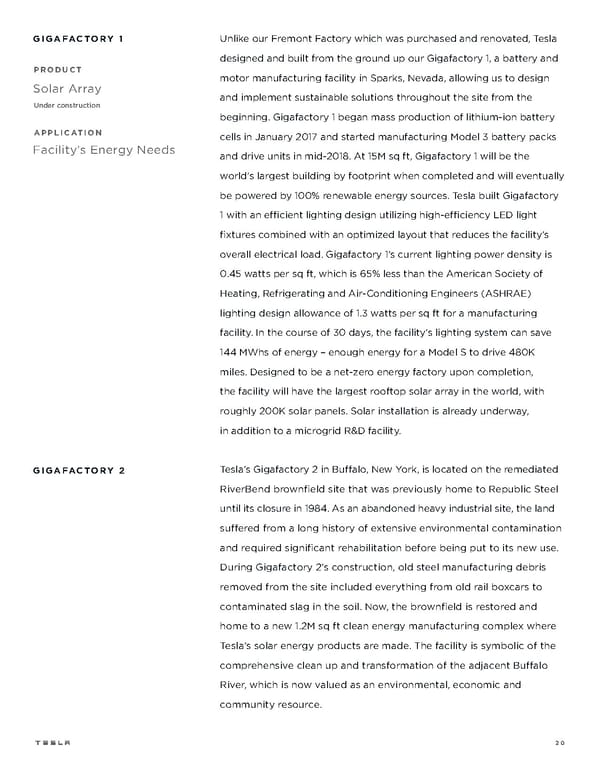GIGAFACTORY 1 Unlike our Fremont Factory which was purchased and renovated, Tesla designed and built from the ground up our Gigafactory 1, a battery and PRODUCT motor manufacturing facility in Sparks, Nevada, allowing us to design Solar Array and implement sustainable solutions throughout the site from the Under construction beginning. Gigafactory 1 began mass production of lithium-ion battery APPLICATION cells in January 2017 and started manufacturing Model 3 battery packs Facility’s Energy Needs and drive units in mid-2018. At 15M sq ft, Gigafactory 1 will be the world's largest building by footprint when completed and will eventually be powered by 100% renewable energy sources. Tesla built Gigafactory 1 with an efficient lighting design utilizing high-efficiency LED light fixtures combined with an optimized layout that reduces the facility’s overall electrical load. Gigafactory 1’s current lighting power density is 0.45 watts per sq ft, which is 65% less than the American Society of Heating, Refrigerating and Air-Conditioning Engineers (ASHRAE) lighting design allowance of 1.3 watts per sq ft for a manufacturing facility. In the course of 30 days, the facility’s lighting system can save 144 MWhs of energy – enough energy for a Model S to drive 480K miles. Designed to be a net-zero energy factory upon completion, the facility will have the largest rooftop solar array in the world, with roughly 200K solar panels. Solar installation is already underway, in addition to a microgrid R&D facility. GIGAFACTORY 2 Tesla’s Gigafactory 2 in Bu!alo, New York, is located on the remediated RiverBend brownfield site that was previously home to Republic Steel until its closure in 1984. As an abandoned heavy industrial site, the land su!ered from a long history of extensive environmental contamination and required significant rehabilitation before being put to its new use. During Gigafactory 2’s construction, old steel manufacturing debris removed from the site included everything from old rail boxcars to contaminated slag in the soil. Now, the brownfield is restored and home to a new 1.2M sq ft clean energy manufacturing complex where Tesla’s solar energy products are made. The facility is symbolic of the comprehensive clean up and transformation of the adjacent Bu!alo River, which is now valued as an environmental, economic and community resource. 20
 Tesla Impact Report | 2019 Page 19 Page 21
Tesla Impact Report | 2019 Page 19 Page 21